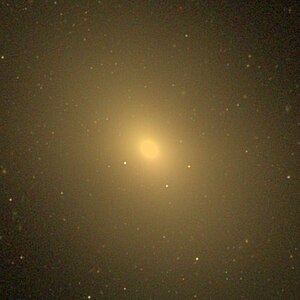NGC 4365
| Galaxy NGC 4365 |
|
|---|---|

|
|
| SDSS recording | |
| AladinLite | |
| Constellation | Virgin |
|
Position equinox : J2000.0 , epoch : J2000.0 |
|
| Right ascension | 12 h 24 m 28.3 s |
| declination | + 07 ° 19 ′ 04 ″ |
| Appearance | |
| Morphological type | E3 |
| Brightness (visual) | 9.6 likes |
| Brightness (B-band) | 10.6 mag |
| Angular expansion | 6.90 × 5.0 |
| Position angle | 40 ° |
| Surface brightness | 13.5 mag / arcmin² |
| Physical data | |
| Affiliation | Virgo cluster WBL 406-001 LGG 289 |
| Redshift | 0.004146 ± 0.000017 |
| Radial velocity | 1243 ± 5 km / s |
|
Stroke distance v rad / H 0 |
(52 ± 4) x 10 6 ly (16.0 ± 1.1) Mpc |
| history | |
| discovery | William Herschel |
| Discovery date | April 13, 1784 |
| Catalog names | |
| NGC 4365 • UGC 7488 • PGC 40375 • CGCG 042-083 • MCG + 01-32-048 • 2MASX J12242822 + 0719030 • VCC 731 • GC 2921 • H I 30 • h 1232 • GALEXASC J122428.23 + 071903.7 • GIN 777 • LDCE 904 NED088 | |
NGC 4365 is an elliptical galaxy of Hubble type E3 in the constellation Virgo to the ecliptic . It is an estimated 52 million light years away from the Milky Way and has a diameter of about 110,000 ly. Under the designation VCC 731 , it is considered a member of the Virgo galaxy cluster .
In the same area of the sky are u. a. the galaxies NGC 4341 , NGC 4342 , IC 3259 , IC 3267 and PGC 40338 .
The object was discovered on April 13, 1784 by the German-British astronomer Wilhelm Herschel .
Web links
Commons : NGC 4365 - collection of images, videos, and audio files
- SIMBAD Astronomical Database
- Spektrum.de : amateur recordings [1] , labeled environment record
